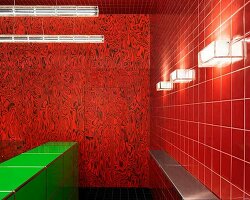
the evolution of Sottsass’ work over a quarter-century is showcased at Friedman Benda

a collection of ‘Yantra’ ceramics reference Indian religious symbols and Aztec sculptures
KEEP UP WITH OUR DAILY AND WEEKLY NEWSLETTERS
from car wheels to the speedometers and gauges, our list explores the automobile aesthetics that appear in modern watches.
connections: +410
discover our guide to milan design week 2025, the week in the calendar where the design world converges on the italian city.
connections: 7
designed to address climate change, soil degradation, and water scarcity, the system saves up space with a vertical setup.
connections: +1100
from the sterile corridors of the severed floor to the curated domestic spaces outside its walls, every element serves a purpose.

 exhibition view | images ©
exhibition view | images ©  early cabinetry is displayed alongside rare, experimental ceramic works
early cabinetry is displayed alongside rare, experimental ceramic works

 on view are works from Sottsass’ long-time collaborations with Poltronova
on view are works from Sottsass’ long-time collaborations with Poltronova




















